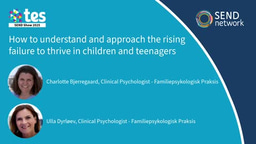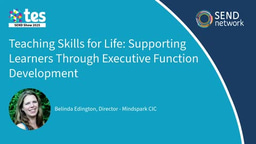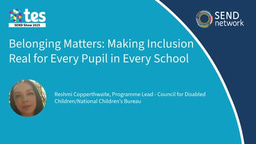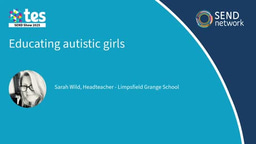It’s never too late: Spotting and supporting SLCN at secondary school

While about one in 10 children and young people are affected by long-term and persistent speech, language and communication needs, research suggests that up to 40% of those with SLCN are going unidentified (PHE, 2020; Communication Trust, 2014).
Furthermore SLCN can be particularly hard to spot in secondary schools, where one study suggests almost half of those affected remain unidentified, compared with 29% in the primary school (Communication Trust, 2014).
The reality is that by the time students arrive in year 7, many have learnt how to mask their difficulties and have honed their coping strategies.
Indeed, it is not surprising that as many as 45% of secondary students who have problems with vocabulary and 52% who have difficulties formulating sentences are not picked up because they have learnt how to manage these issues and hide them from teachers (Communication Trust, 2014).
“At secondary school, there are so many more demands placed on students and more emphasis is placed on their language and communication skills and their executive functioning,” explained Yin Collighan, a specialist paediatric speech and language therapist with Speech & Language Link.
“Their abilities in those areas are still developing as they try to process more complex and nuanced language and larger chunks of information. There will also be greater social expectations at secondary, with lots of different subject teachers and different peer relationships.
“Basically, secondary schools are bigger and filled with many more people, and all of this – combined with difficult adolescent years – means there are many more challenges to navigate.”
Many children with unidentified SLCN have learnt how to cope with their difficulties during years of primary education by masking or copying what their classmates do.
And just as the increased demands of the curriculum might expose their issues in the secondary classroom, the “larger” school environment might equally give them more space to hide from teachers and support staff, who will also take much longer to get to know them well.
Ms Collighan continued: “A lot of children will have worked out how they can get by, but unless their problems are identified and addressed, they could find themselves quickly falling behind.”
Identifying children with SCLN in the classroom
There are give-away clues that suggest a student may be struggling with language in the classroom.
They may be particularly quiet and not volunteer answers, nor participate in discussions. Their contribution in lessons may be minimal unless specifically called upon.
Putting words together into complex sentences may be difficult, or they might not be able to follow instructions from the teacher.
“What may look like defiance or laziness could simply be difficulties understanding what is going on,” Ms Collighan continued. “Some children with SLCN can be restless or disengaged in lessons as they struggle to keep up. They might talk off-topic or provide vague responses because they just can’t find the right words.
“Others might present as the ‘class clown’ because it is their way of distracting from their underlying language difficulties.”
Some children may also display more extreme behaviours, such as self-harm or may be struggling with eating disorders, as well as issues like anxiety and school avoidance. Research tells us that around 8 in 10 children with emotional and behaviour disorders usually have unidentified language difficulties (Hollo et al, 2014).
Emma Price, who is also a Speech & Language Link specialist paediatric speech and language therapist, said that early screening in secondary schools, in year 7, was the best way of identifying SLCN.
“I recently met with a secondary school SENCO who decided to screen the children on the SEN register whose primary need was recorded as social, emotional and mental health (SEMH). She found that 90% of them had SLCN but that this had not previously been detected.
“This was a revelation to the SENCO and has led her to want to screen all SEMH pupils on the SEN register when they enter the school from their local feeder primary schools so that the appropriate interventions, if required, can be put in place as soon as possible.”
The results of this school’s screening are perhaps not surprising. SLCN are now the most common needs for children on SEN Support (DfE, 2024) and anecdotally teaching staff are reporting seeing children less able to express themselves and articulate their views and feelings since Covid.
Teaching strategies in the classroom
When teachers are aware of which children in their class have SLCN – including which type of SLCN – they can implement appropriate strategies.
One of the most important goals at secondary age, Ms Collighan explained, is self-advocacy and independence: “Giving students the confidence to say when they are having difficulties is very important.”
Using whole-class strategies with resources or approaches that boost language and communication skills for all students can really help: “This way, children with SLCN don’t feel they’re the only ones who find something difficult. Having an ‘open-door’ approach is also crucial so that students know they can talk to a teacher and have a one-to-one conversation if they’re uncertain. This could be with the SENCO or their form tutor, for example.”
Another effective strategy is breaking down instructions and tasks into more manageable chunks – again something that could help all students.
Ms Price explained: “Teachers need to consider if their instructions contain too many words or if they are too long and difficult to grasp. They might need to speak at a slower pace and consider giving less information at one time.”
Instructions and information can also be made more accessible by presenting them visually through other media, such as short videos and diagrams/illustrations.
Other strategies can include introducing or pre-teaching key vocabulary or definitions at the start of a lesson.
At the same time, students with SLCN can be encouraged to present their work in alternative ways, such as using pictures or recordings where possible, acknowledging that there are many forms of communication.
One secondary school which screened all year 7 pupils this academic year reported that this enabled learning support staff the time to get an overview of every student, thus helping them to identify potential challenges with engagement and behaviour in lessons. The support staff were then able to report their observations back to the SENCO and subject teachers.
This approach also gave students an opportunity to get to know the learning support staff and feel comfortable talking to them about anything they were finding tricky in class.
Role of the SENCO
SENCOs should have a proactive approach to meeting the needs of SLCN children. As discussed, screening everyone in year 7 will identify those students who require additional help and working with these children would reduce the many challenges they could face if support was not given.
Speech & Language Link has a package of tools which will support SENCOs to promptly identify these students, as well as interventions and expert advice from its team of speech and language therapists.
SENCOs can also carry out audits and organise high-quality staff training on SLCN so that every member of staff is aware of what SLCN might look like, understands the impact of unsupported SLCN, and knows how to proceed to the next level of support as necessary.
Ms Collighan continued: “It is useful for all staff members to have similar, good levels of knowledge about speech, language and communication so that its importance becomes part of the culture of the school.”
Staff training and CPD are crucial to meeting the needs of SLCN children. Ms Collighan added: “Staff should have regular meetings to talk about specific students so that they can coordinate approaches to teaching and support. This might include using the same visuals or sharing resources.
“We strongly encourage such levels of collaboration. If teachers see their strategies are working well, they should let other teachers know. This helps to keep all teachers on board and provides consistency for the student.
“SENCOs have a big role to play in engaging with subject teachers and discussing the impact that they are having with the students. Sometimes that means jointly coming up with strategies and checking in regularly to see how they are working.”
From a student’s perspective, a child with SLCN may not like being seen as different from their peers, Ms Price added. “Students with SLCN often don’t want everyone to know they are using different resources or approaches, so if the staff working with them can share information with colleagues on whole class adaptations, then the student won’t feel singled out – and everyone can benefit because they will be strategies that every student can use.”
Final thoughts
It is important for school staff to be aware that SLCN still exist at secondary level and that these issues are not something that these students will just “grow out of”.
It is also useful to show teaching staff what the research says about just how many children will arrive in secondary school each year with hidden SLCN.
For some children, SLCN will present challenges throughout their school lives (and throughout adulthood), and they will need constant and consistent help and support. This means finding ways to help them to engage and participate as well as building their confidence.
Ms Collighan added: “SLCN can often be hard to spot, but that doesn’t mean we shouldn’t look for it. For teachers this might mean admitting to colleagues/the SENCO that you need help to support students or some additional training. It might be helpful to observe other teachers to see how they support their students with SLCN or to work collaboratively.
“Remember – it is never too late to identify SLCN and it is never too late to consider what appropriate strategies we can put in place.”
Further information & resources
- Communication Trust: Talk of the Town: Evaluation report, 2014.
- DfE: Academic year 2023/24: Special educational needs in England, June 2024: Click here.
- Hollo, Wehby & Oliver: Unidentified language deficits in children with emotional and behavioral disorders, Exceptional Children (80,2), 2014: https://doi.org/10.1177/001440291408000203
- Public Health England: Best start in speech, language, and communication: Supporting evidence, 2020.
- Speech & Language Link: The Speech and Language Building Blocks of Oracy (blog post by Yin Collighan), 2024: Click here.
Sponsored content: This article has been published by SecEd with sponsorship from Speech & Language Link. It has been written and produced to a brief agreed in advance with Speech & Language Link.
Photo credit: Adobestock





Please sign in or register for FREE
If you are a registered user on SEND Network, please sign in